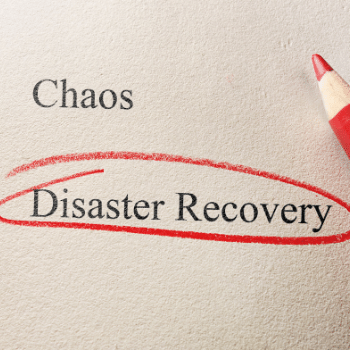How does a disaster recovery (DR) plan work?
 A disaster recovery (DR) plan is a formal document created by an organization that contains detailed instructions on how to respond to unplanned incidents such as natural disasters, power outages, cyber attacks and any other disruptive events. The plan contains strategies on minimizing the effects of a disaster, so an organization will continue to operate – or quickly resume key operations.
A disaster recovery (DR) plan is a formal document created by an organization that contains detailed instructions on how to respond to unplanned incidents such as natural disasters, power outages, cyber attacks and any other disruptive events. The plan contains strategies on minimizing the effects of a disaster, so an organization will continue to operate – or quickly resume key operations.
Disruptions can lead to lost revenue, brand damage and dissatisfied customers. And, the longer the recovery time, the greater the adverse business impact. Therefore, a good disaster recovery plan should enable rapid recovery from disruptions, regardless of the source of the disruption.
A DR plan is more focused than a business continuity plan and does not necessarily cover all contingencies for business processes, assets, human resources and business partners.
A successful DR solution typically addresses all types of operation disruption and not just the major natural or man-made disasters that make a location unavailable. Disruptions can include power outages, telephone system outages, temporary loss of access to a facility due to bomb threats, a "possible fire" or a low-impact non-destructive fire, flood or other event. A DR plan should be organized by type of disaster and location. It must contain scripts (instructions) that can be implemented by anyone.
Before the 1970s, most organizations only had to concern themselves with making copies of their paper-based records. Disaster recovery planning gained prominence during the 1970s as businesses began to rely more heavily on computer-based operations. At that time, most systems were batch-oriented mainframes. Another offsite mainframe could be loaded from backup tapes, pending recovery of the primary site.
In 1983 the U.S. government mandated that national banks must have a testable backup plan. Many other industries followed as they understood the significant financial losses associated with long-term outages.
By the 2000s businesses had become even more dependent on digital online services. With the introduction of big data, cloud, mobile and social media, companies had to cope with capturing and storing massive amounts of data at an exponential rate. DR plans had to become much more complex to account for much larger amounts of data storage from a myriad of devices. The advent of cloud computing in the 2010s helped to alleviate this disaster recovery complexity by allowing organizations to outsource their disaster recovery plans and solutions, also known as disaster recovery as a service (DRaaS).
Another current trend that emphasizes the importance of a detailed disaster recovery plan is the increasing sophistication of cyber attacks. Industry statistics show that many attacks stay undetected for well over 200 days. With so much time to hide in a network, attackers can plant malware that finds its way into the backup sets – infecting even recovery data. Attacks may stay dormant for weeks or months, allowing malware to propagate throughout the system. Even after an attack is detected, it can be extremely difficult to remove malware that is so prevalent throughout an organization.
Business disruption due to a cyber attack can have a devastating impact on an organization. For instance, cyber outage at a package delivery company can disrupt operations across its supply chain, leading to financial and reputational loss. And in today’s digitally-dependent world, every second of that disruption counts.
Why is a DR plan important?
The compelling need to drive superior customer experience and business outcome is fueling the growing trend of hybrid multicloud adoption by enterprises. Hybrid multicloud, however, creates infrastructure complexity and potential risks that require specialized skills and tools to manage. As a result of the complexity, organizations are suffering frequent outages and system breakdown, coupled with cyber-attacks, lack of skills, and supplier failure. The business impact of outages or unplanned downtime is extremely high, more so in a hybrid multicloud environment. Delivering resiliency in a hybrid multicloud requires a disaster recovery plan that includes specialized skills, an integrated strategy and advanced technologies, including orchestration for data protection and recovery. Organizations must have comprehensive enterprise resiliency with orchestration technology to help mitigate business continuity risks in hybrid multicloud, enabling businesses to achieve their digital transformation goals
Other key reasons why a business would want a detailed and tested disaster recovery plan include:
- To minimize interruptions to normal operations.
- To limit the extent of disruption and damage.
- To minimize the economic impact of the interruption.
- To establish alternative means of operation in advance.
- To train personnel with emergency procedures.
- To provide for smooth and rapid restoration of service.
To meet today's expectation of continuous business operations, organizations must be able to restore critical systems within minutes, if not seconds of a disruption.
Adapted from: What is a disaster recovery (DR) plan | IBM
